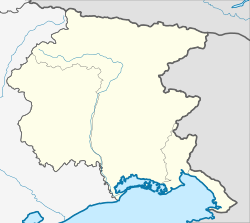Campoformido
Campoformido | |
|---|---|
| Comune di Campoformido | |
show Location of Campoformido | |
 Campoformido Location of Campoformido in Italy | |
| Coordinates: 46°1′N 13°10′E / 46.017°N 13.167°ECoordinates: 46°1′N 13°10′E / 46.017°N 13.167°E | |
| Country | Italy |
| Region | Friuli-Venezia Giulia |
| Province | Udine |
| Frazioni | Basaldella, Bressa, Villa Primavera |
| Government | |
| • Mayor | Erika Furlani |
| Area | |
| • Total | 21.98 km2 (8.49 sq mi) |
| Elevation | 78 m (256 ft) |
| Population (31 December 2019)[2] | |
| • Total | 7,743 |
| • Density | 350/km2 (910/sq mi) |
| Demonym(s) | Compoformidesi |
| Time zone | UTC+1 (CET) |
| • Summer (DST) | UTC+2 (CEST) |
| Postal code | 33030 |
| Dialing code | 0432 |
| Website | Official website |
Campoformido (Friulian: Cjampfuarmit) is a town and comune in Friuli-Venezia Giulia, north-eastern Italy, with a population of 7743 (December 2019).[3] It is notable for the Treaty of Campo Formio.
History[]
Campoformido is a village not far from Udine. It is known for the 1797 Treaty of Campo Formio signed between Napoleonic France and Austria, in which Napoleon ceded Veneto to Austria in exchange for Lombardy. The treaty enacted the dissolution of the Republic of Venice.
The treaty was signed by General Bonaparte and four representatives of the Habsburgs at the house of Bertrando Del Torre, a merchant, located in what is now the Trattato (Treaty) square.[4] The house is open to visitors. To commemorate the event, two monuments, one placed outside the house and one inside, remained covered with lime for a long time after the fall of Napoleon. There is also, in the same square, a copy of the Statue of Peace; the original was brought to Udine and is located in Piazza della Libertà.
References[]
- ^ "Superficie di Comuni Province e Regioni italiane al 9 ottobre 2011". Istat. Retrieved 16 March 2019.
- ^ "Popolazione Residente al 1° Gennaio 2018". Istat. Retrieved 16 March 2019.
- ^ Demo.istat.it http://demo.istat.it/bilmens2019gen/index.html. Retrieved 27 December 2020. Missing or empty
|title=(help) - ^ Carlo Passaglia (1865). Il Mediatore: giornale settimanale politico, religioso, scientifico, letterario, Parte 2. Tipografia del Mediatore.
External links[]
- Municipalities of the Province of Udine
- Cities and towns in Friuli-Venezia Giulia
- Friuli-Venezia Giulia geography stubs



